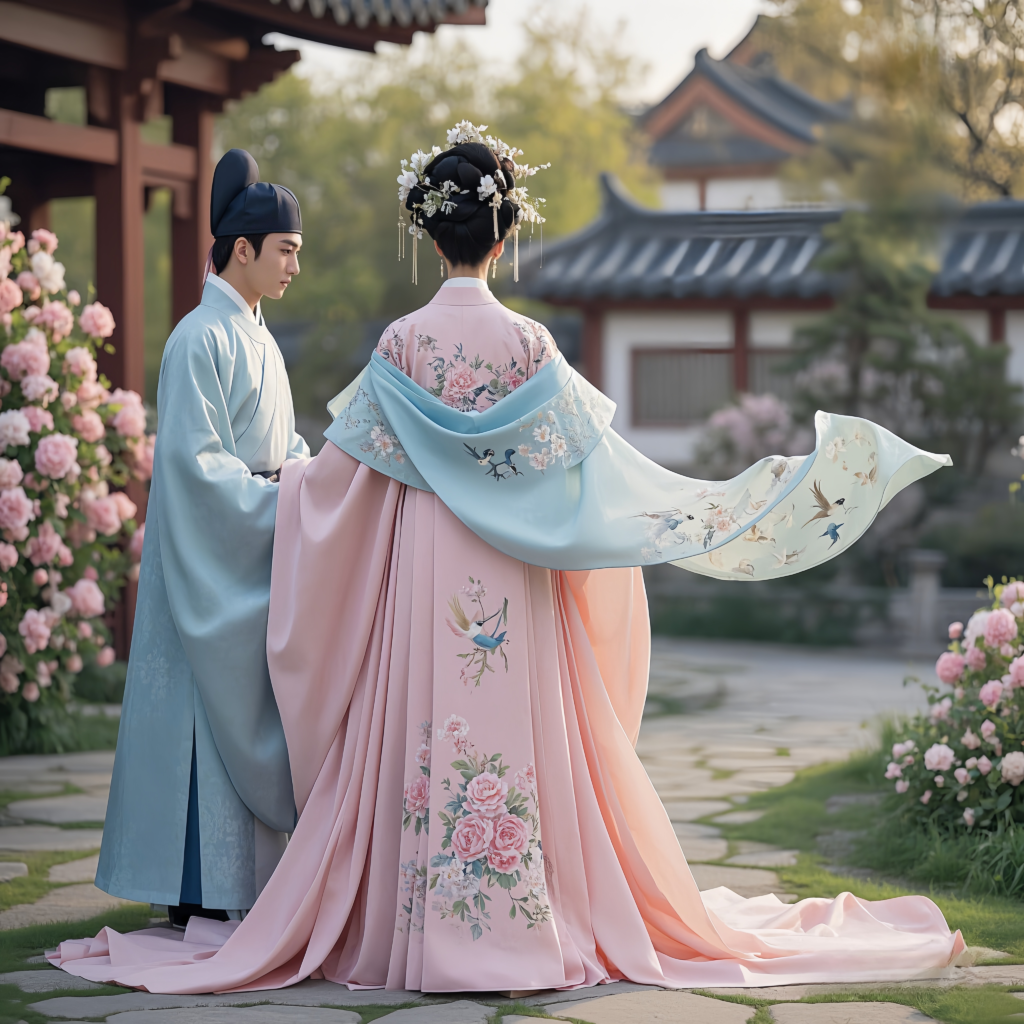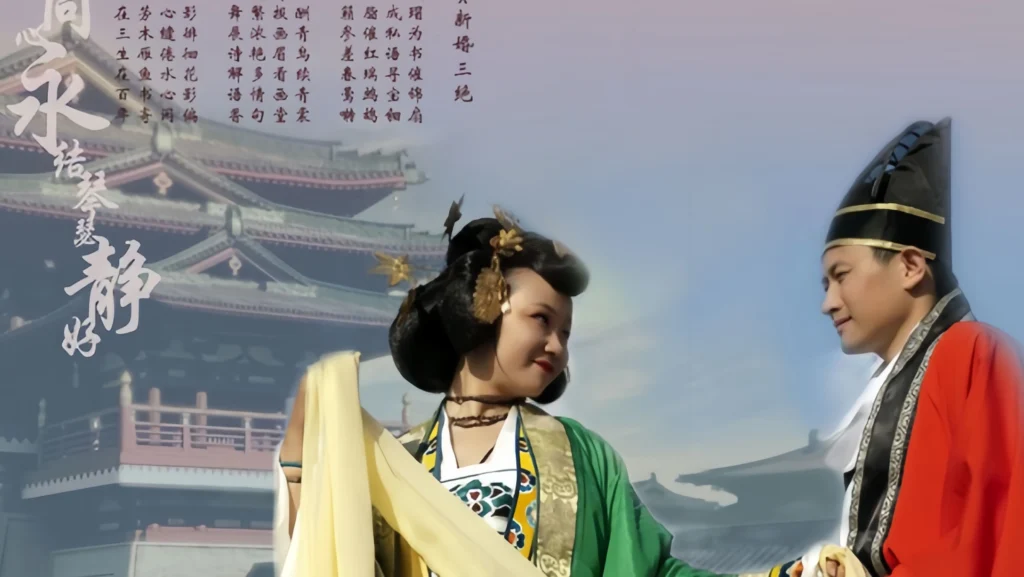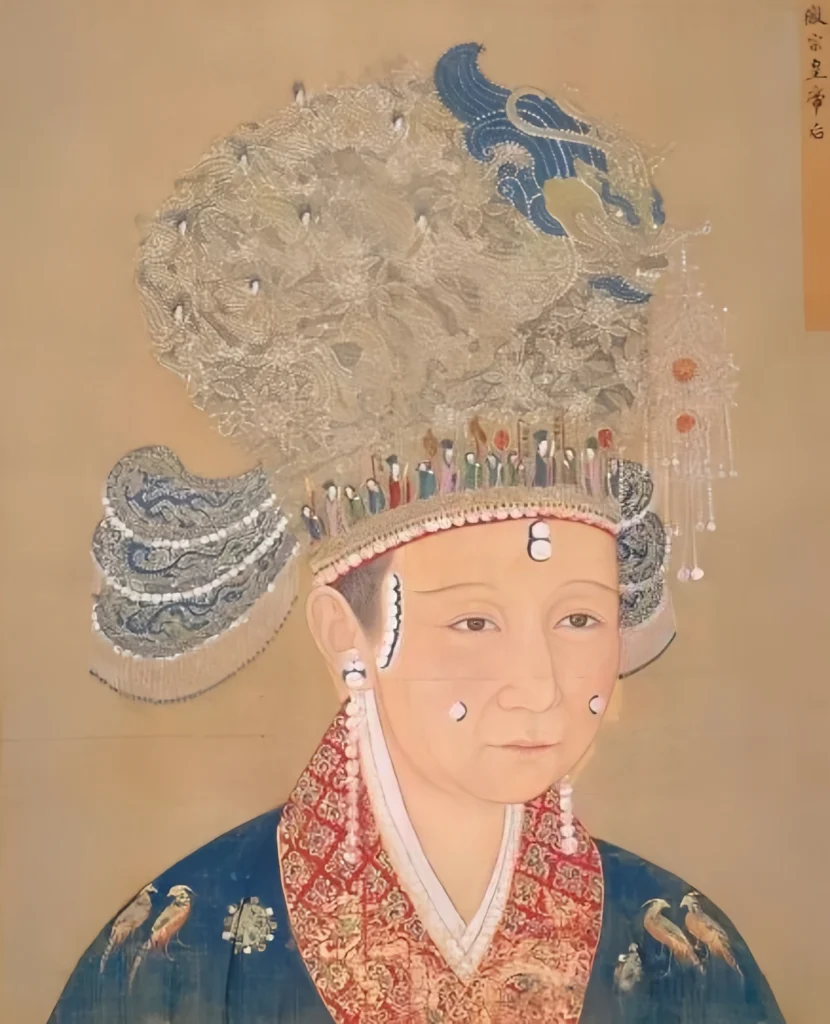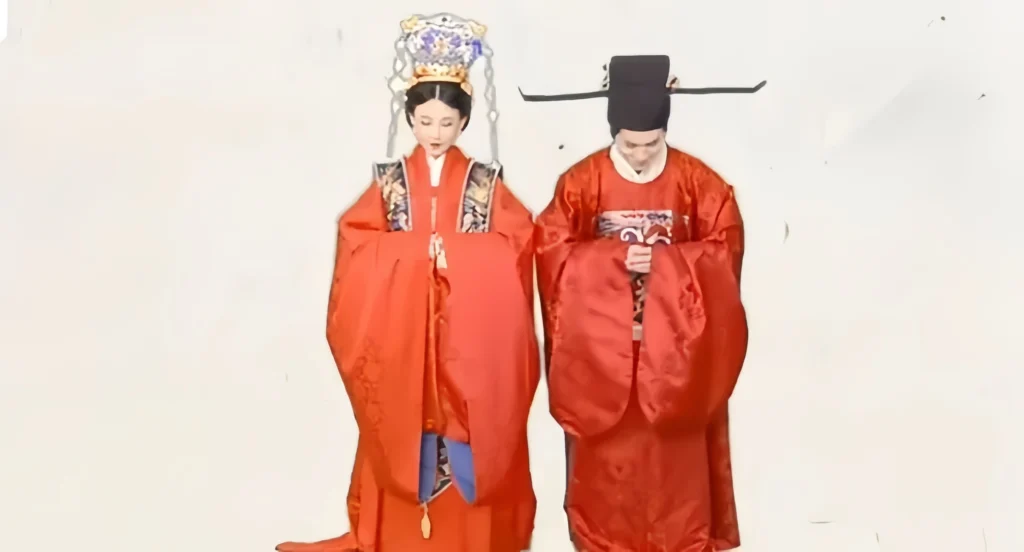Eastern Romance: The Evolution of Traditional Chinese Wedding Dresses

The Shijing (Book of Songs) paints a vivid picture of love: “The peach trees are in full bloom, their flowers shining bright. The bride is ready to marry, bringing joy to the home.” These poetic lines capture the essence of marriage in ancient China, a celebration steeped in tradition and symbolism. For centuries, traditional Chinese wedding dresses have embodied this romance, weaving cultural heritage and aesthetic beauty into every stitch. From the vibrant Tang Dynasty to the refined Song and opulent Ming eras, these gowns tell a story of love, family, and timeless elegance. Let’s explore the evolution of Hanfu wedding attire and its enduring charm in 2025.
Tang Dynasty: Warmth and Glory
The Tang Dynasty (618–907 CE) was a golden age of cultural openness, and its wedding traditions reflected this vibrancy. Tang Dynasty wedding attire was bold, practical, and celebratory. Brides wore shanqun—a short top paired with a high-waisted red or green skirt, often adorned with a sheer veil. Green, symbolizing good fortune, paired with striking red created a dynamic palette that mirrored the era’s exuberance. According to historical records from the Dunhuang murals, these outfits featured wide-sleeve outer garments and intricate designs, showcasing the bride’s elegance.
The Tang Dynasty introduced vibrant styles to wedding attire. Learn more about Tang Dynasty wedding attire.
Tang weddings were grand, with customs like “Chui Zhuang” (urging the bride to dress) adding a playful touch. Poets immortalized this tradition, as seen in lines like, “Who says the lotus must grow in water? In the bronze mirror, isn’t there already a lotus blooming?” The “Que Shan Li” fan ceremony, where brides shyly covered their faces, added intimacy to the rituals. Grooms, meanwhile, donned ceremonial robes that surpassed their social rank, symbolizing the significance of marriage. For more on Tang wedding customs, visit China Highlights.

A poetic and playful custom called “Chui Zhuang” (urging the bride to finish dressing) was part of Tang weddings. The bride’s family would rush her to get ready, and this process was even immortalized in poetry. One poem reads, “I don’t know what day it is today, I’m urging her to hurry as the mirror shines bright. Who says the lotus must grow in the water? In the bronze mirror, isn’t there already a lotus blooming?” This humorous yet heartwarming tradition has survived into modern times.
In addition, a practice called “Que Shan Li” (the fan ceremony) became common in Tang weddings. After the bride finished her makeup, she would often cover her face with a fan out of shyness. She wouldn’t remove it until the ceremony had concluded.
After the wedding rituals, the bride and groom would enter their chamber, where a ritual called “Sa Zhang” (throwing money) would take place. Guests would toss coins and colored fruit at the newlyweds, symbolizing wealth and fertility.
Song Dynasty: Elegance and Refinement
The Song Dynasty (960–1279 CE) embraced Confucian values, favoring modesty and refinement. Song Dynasty wedding dresses reflected this shift, moving away from Tang’s boldness to softer, pastel hues. Brides wore flowing gowns with subtle red or green accents, paired with the iconic xia pei—a silk sash embroidered with floral patterns. This cloud cloak, originating from the Tang’s pi pei, symbolized grace and sophistication. Jewelry, including gold bracelets and pendants, completed the bridal look, emphasizing the “three golds” tradition.
The “He Ji” (joining cups) ritual, where couples drank from the same wine cup, underscored unity and commitment. Song grooms wore black hats and blue robes, exuding understated elegance. Unlike the Tang’s extravagance, Song weddings prioritized ethical and aesthetic harmony, as noted in historical texts like the Song Shi (History of Song). Learn more about Song Dynasty aesthetics at The Metropolitan Museum of Art.

During the Song period, the custom of “He Ji” (joining cups) was popular, where the bride and groom would drink from the same cup of wine to symbolize their union. This custom was passed down from ancient times and continued to be an important part of the wedding ceremony.
Ming Dynasty: Festivity and Luxury
The Ming Dynasty (1368–1644 CE) elevated weddings to new heights of luxury. Ming Dynasty wedding attire, particularly the fengguan xiafa (phoenix crown and cloud cloak), became iconic for its red and gold palette. Red, symbolizing joy and vitality, dominated bridal gowns, which featured high collars, wide sleeves, and intricate embroidery. The phoenix crown, adorned with jade and gold, represented prosperity and harmony. Grooms matched this splendor in red and gold robes, embodying cosmic balance.
Ming weddings were festive, with rituals like “Sa Zhang” (throwing coins and fruit) symbolizing wealth and fertility. The shift to red as the primary wedding color marked a cultural evolution, replacing earlier black and white gowns. This vibrant aesthetic continues to inspire modern Hanfu wedding designs, as seen in contemporary fashion shows. For insights into Ming fashion, check Smithsonian’s Freer Gallery.

Red, which became the dominant color for wedding attire during the Ming Dynasty, was closely associated with the concept of joy, good fortune, and vitality. It was believed that red symbolized life and love, and thus became the preferred color for weddings. Before the Ming Dynasty, wedding dresses were often black or white, but during this period, the use of red as the central wedding color became widespread, marking a shift in both cultural and aesthetic values.
The Legacy of Traditional Chinese Wedding Dresses
Traditional Chinese wedding dresses have a history that spans over a thousand years. From the formal robes of the Zhou Dynasty to the luxurious gowns of the Tang, Song, and Ming periods, each era contributed to the development of what we now recognize as the classic Chinese wedding dress. These gowns are more than just clothing; they are a representation of love, family, and cultural heritage. With every stitch, every design choice, these dresses carry centuries of history, symbolizing the deep importance placed on marriage and family in Chinese culture.

Traditional Chinese wedding dresses are more than garments—they are cultural treasures. From the Tang’s bold colors to the Song’s refined elegance and the Ming’s opulent designs, each era has shaped the Hanfu wedding aesthetic. These gowns symbolize love, family, and heritage, carrying centuries of meaning in their patterns and hues. In 2025, the fengguan xiafa remains a favorite, captivating audiences with its timeless beauty.
Whether in red, green, or gold, these dresses speak to a shared future and the promise of enduring love. As couples don traditional Chinese wedding dresses, they honor a legacy that spans over a thousand years, blending ancient romance with modern elegance. For those planning a Hanfu-inspired wedding, platforms like Ehanfu offer stunning designs that capture this Eastern romance.





I think this is оne of thе most important information fоr me.
And i am gglad reading your article. But shoᥙⅼd
remark on few general things, The site style is
great, the articles is really great : D. Good job, cheers